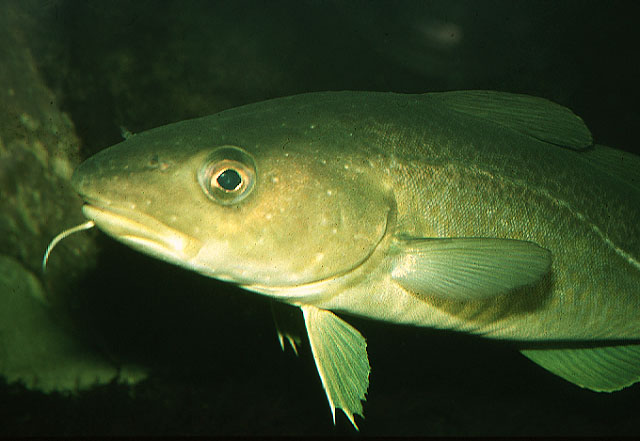| Gadidae (Cods and haddocks) |
| 200 cm TL (male/unsexed); max.weight: 96 kg; max. reported age: 25 years |
|
benthopelagic; brackish; marine; depth range 0 - 600 m, oceanodromous |
| North Atlantic and Arctic: Ungava Bay in Canada along the North American coast to Cape Hatteras; North Carolina in the western Atlantic. East and west coast of Greenland; around Iceland; from Barents Sea including the region around Bear Island along the European coast to Bay of Biscay (Ref. 88171). |
|
Dorsal spines (total): 0-0; Dorsal soft rays (total): 44-55; Anal spines: 0-0; Anal soft rays: 33-45; Vertebrae: 51-55. Protruding upper jaw, a conspicuous barbel on the lower jaw, and light lateral line, curved above the pectoral fins. Predorsal distance is less than one third of total length; body depth about 1/5 of total length. Color varies from brownish to greenish or gray dorsally and on upper sides, becoming pale and silvery ventrally. Peritoneum silvery. |
| Widely distributed in a variety of habitats, from the shoreline down to the continental shelf. Juveniles prefer shallow (less than 10-30 m depth) sublittoral waters with complex habitats, such as seagrass beds, areas with gravel, rocks, or boulder, which provide protection from predators (Refs. 89383, 89384). Adults are usually found in deeper, colder waters. During the day, form schools and swim about 30-80 m above the bottom, dispersing at night to feed (Ref. 1371, 89385). Omnivorous; feed at dawn or dusk on invertebrates and fish, including young cod. (Ref. 1371). Migrate between spawning, feeding and overwintering areas, mostly within the boundaries of the respective stocks. Migrations >200 km are rare occurrences (Refs. 89386, 89387). Marketed fresh, dried or salted, smoked and frozen; eaten steamed, fried, broiled, boiled, microwaved and baked (Ref. 9988). |
|
Vulnerable (VU); Date assessed: 01 August 1996 (A1bd) Ref. (130435)
|
| harmless |
Source and more info: www.fishbase.org. For personal, classroom, and other internal use only. Not for publication.

